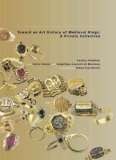

- Gold rings from the Thetford treasure, Roman Britain, 4th century
- Gold ring with a cross in garnets and mother-of-pearl, Frankish, 450-525
- Ring with cloisonné, Merovingian France, c. 475-550 (also here and here)
- Gold ring, c. 5th-7th centuries
- Gold signet ring inscribed "ROSA," Merovingian France, 6th century
- Gold signet ring inscribed "TRASILO," Merovingian France, 6th century
- Gold signet ring, Merovingian France, 6th century
- Gold ring with a green stone, Merovingian France, 6th century (also here, here, and here)
- Undecorated gold ring, Merovingian France, 6th century (also here and here)
- A jet ring in the Bréban grave group, Merovingian France, early to mid-6th cnetury
- Engraved gold ring with a beryl, Byzantium, mid-6th century
- Wedding ring with an inscription relating to Queen Arnegonde, c. 570
- Gold ring, Merovingian France, 6th-7th century
- Gold ring with missing stone, Merovingian France, 6th-7th century (also here and here)
- Gold ring with a pyramid-shaped garnet, Merovingian France, c. 500-620
- The Gumedruta ring (a gold seal-ring with a female bust and inscription), Lombardic or Ostragothic Italy, 6th-early 7th centuries
- Gold ring with an engraved top, Merovingian France, c. 600 (also here and here)
- Gold ring inscribed with the names Dromacius and Betta and the figures of a man and woman, Merovingian France, late 6th-early 7th centuries
- Gold ring with pearls, Byzantium, 7th century
- Gold wedding ring, Byzantium, 7th century
- Silver-gilt ring with a garnet, Merovingian France, 7th century (also here and here)
- Gold ring set with glass beads, Anglo-Saxon (found in Oxfordshire), 7th century
- Pair of royal finger rings engraved (with niello) with inscriptions relating to an Anglo-Saxon king and queen, England, 9th century
- Silver ring formed from a strip of rectangular-section silver, the ends of which have been tapered for coiling around each other; found in northern England and dated to the 9th-10th centuries
- Copper-alloy ring of the late Anglo-Saxon period (c. 9th-11th century), found in Kent
- Silver rings in the Cuerdale hoard, possibly made in Dublin c. 900
- Silver and gold rings from early medieval Sweden: twisted gold (2485:3), silver (SHM 4858:8), and silver (SHM 4858:9).
